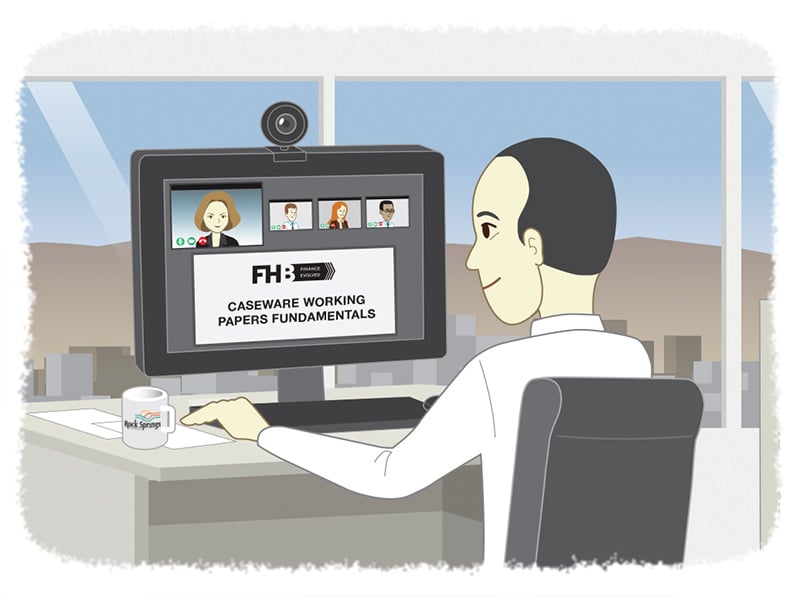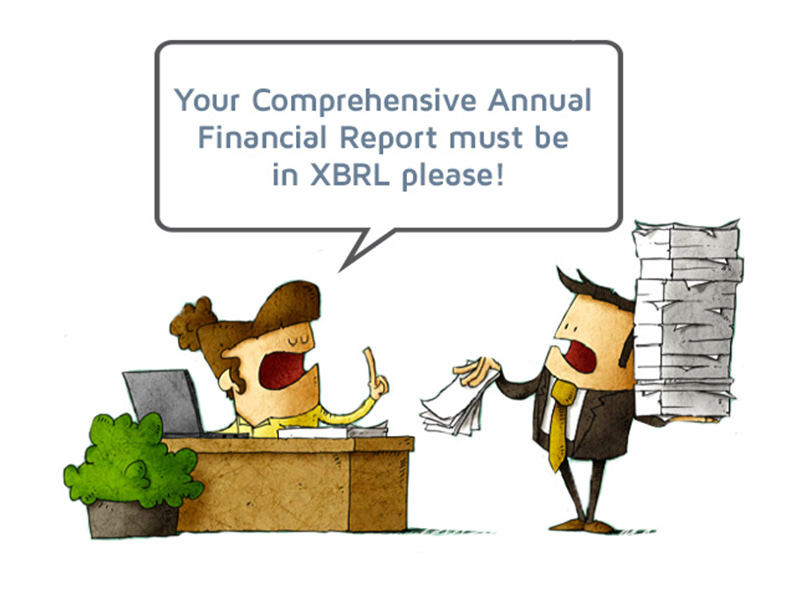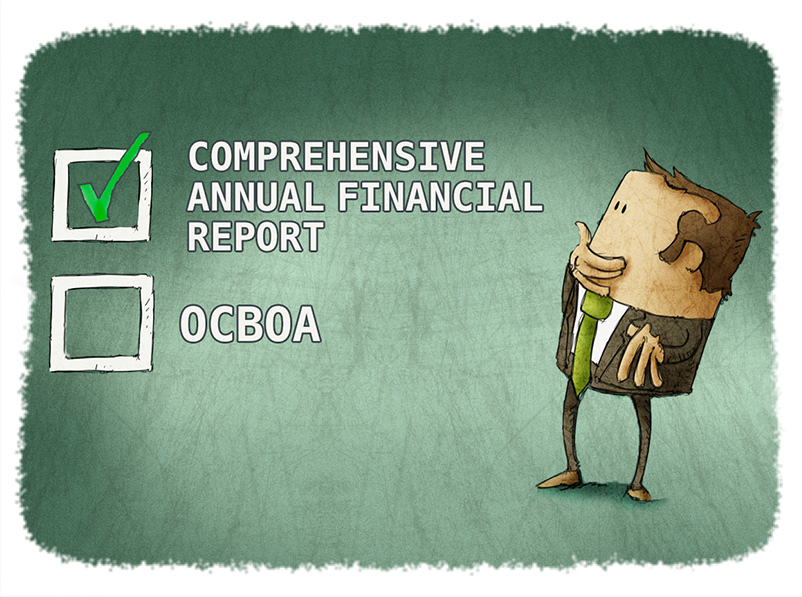The ADA & US Government: What you need to know in 6 minutes
- Jamie Black
- Financial Reporting
- minute(s)While many have heard of the Americans with Disability Act (ADA), few truly understand its importance: Why should a finance or budget professional care about it? What do the laws (there are three) specifically require? How must I comply with the laws? This article answers these questions. 1) Finance & Budget Departments Should Care Designing documents that are easily understood by your audience is challenging. When some of your audience have visual impairments, there is an additional set of considerations. There are three primary reasons you should care about this topic: As a public sector organization, you want your message available to everyone. Approximately 5.5 million people have visual impairment in North America today. This is expected to double by 2050. To “read” your Comprehensive Annual Financial Report or Budget Book, visually impaired individuals must use assistive technology. These tools read the PDF to them electronically. Unless specifically designed for accessibility however, your PDFs will not be readable by assistive technology. Your organization is legally required to ensure all public documents are accessible (readable by assistive technology). Accessibility for your documents is legally mandated if: you work in a local government, a federal agency, or, a place of "public accommodation" (privately-owned, leased or operated facilities like hotels, restaurants, retail merchants, doctor’s offices, golf courses, private schools, daycare centers, health clubs, sports stadiums, movie theaters, and so on), and you are located in the United States, and you publish content to a publicly accessible website. Numerous lawsuits have been launched for failure to ensure accessibility both for businesses and local governments. As identified by Seyfarth Shaw LLP, these lawsuits are becoming more and more prevalent. 2) The Laws Mandate Accessibility Section 508 of the Rehabilitation Act of 1973 In 1998, Congress amended the Rehabilitation Act of 1973 to require Federal agencies to make their Electronic and Information Technology (EIT) accessible to people with disabilities. The law (29 U.S.C § 794 (d)) applies to all Federal agencies when they develop, procure, maintain, or use electronic and information technology. Under Section 508, agencies must give disabled employees and members of the public access to information comparable to the access available to others. On January 18, 2017, the U.S. Access Board published a final rule updating accessibility requirements for Information and Communication Technology (ICT) covered by Section 508 of the Rehabilitation Act and Section 255 of the Communications Act. E205.4 of this final rule stipulates the accessibility standard mandated by Section 508: Electronic content shall conform to Level A and Level AA Success Criteria and Conformance Requirements in Web Content Accessibility Guidelines ( WCAG 2.0) (incorporated by reference, see 702.10.1). Americans with Disabilities Act (ADA) It was signed into law on July 26, 1990, by President George H.W. Bush. The ADA is one of America's most comprehensive pieces of civil rights legislation that prohibits discrimination and guarantees that people with disabilities have the same opportunities as everyone else. The ADA has three "Titles" (think sections), and it is Title II that applies to the programs and activities of state and local government (title I is employment practices and title III covers private entities that are considered public accommodations). While the ADA does not explicitly reference requirements for web content, the Department of Justice (DOJ) Civil Rights division has confirmed their opinion that the ADA does in fact cover content on web sites. Unfortunately, there is no technical definition for ensuring your web content complies with the ADA. Congress sought clarification from the DOJ in 2018, but their response was noncommittal as to the standard required: Absent the adoption of specific technical requirements for websites through rulemaking, public accommodations have flexibility in how to comply with the ADA's general requirements of nondiscrimination and effective communication. In late July 2019, a series of questions were again raised to the DOJ from several senators looking for clarification. In particular, the senators attempted to learn if the DOJ "consider WCAG 2.0 an acceptable compliance standard". No response from the DOJ has been received as of this writing. California Assembly Bill No. 434 This legislation states that by July 1, 2019 all web content of the state agency or entity must meet... the Web Content Accessibility Guidelines 2.0, or a subsequent version, published by the Web Accessibility Initiative of the World Wide Web Consortium at a minimum Level AA success criteria. 3) Standards Determine Compliance Web Content Accessibility Guidelines (WCAG) Two of the three pieces of legislation above specifically reference Web Content Accessibility Guidelines 2.0 as the relevant standard that our documents must conform to. These guidelines were developed by the World Wide Web Consortium (W3C), an international community that develops open standards for the Web. WCAG 2.0 contains 12 guidelines designed to make content published on the web more accessible for those with impairment. Testable criteria are also provided to allow for the assessment of your content. Any piece of content can be assessed into one of three levels of conformance : A (lowest), AA, and AAA (highest). Note that the legislation mentioned above specify the level that your content must achieve. PDF/Universal Accessibility (PDF U/A) We mention this standard here as you may hear it and be confused by it. PDF/UA is the informal name for ISO 14289, the International Standard for accessible PDF technology. A technical specification intended for developers implementing PDF writing and processing software, PDF/UA provides definitive terms and requirements for accessibility in PDF documents and applications. PDF/UA defines the technical specifications to enable PDF documents to meet WCAG 2.0, but WCAG 2.0 has additional requirements that call for an author’s attention. For these and other additional requirements, the W3C’s technique documents (both general and PDF-specific techniques) guide authors interested in complying with WCAG 2.0. In short, if you are a state or local government in the United States and want to be confident that you comply with the various pieces of legislation, all content you publish to the web must conform to WCAG 2.0 level AA standard. Watch this space for our next article on the technical requirements of WCAG 2.0 and a methodology to employ to make your published documents fully compliant with the standards mandated by the ADA, Section 508, and California Bill 434. © 2025 FH Black Inc. All rights reserved. Content may not be reproduced, excerpted, distributed, or transmitted without prior written consent.
Accessibility - Why should finance & budget professionals care? What do the laws (3!) require? How can you comply? This article provides the answers.
READ MORE
What do you mean? How to be sure your readers understand you
- Jamie Black
- Financial Reporting
- minute(s)Communicating is difficult at the best of times. When our topic is complex and, let's be honest, boring, the job is even harder. In this article, we will tackle one very useful technique for ensuring the readers of your financial reports and budget books understand what you are attempting to convey. The single biggest problem in communication is the illusion that it has taken place. George Bernard Shaw As we have discussed in previous posts, text is one of the three essential tools at your disposal when trying to communicate non-verbally. Recall, the purpose of text is to: introduce a topic, a problem, a business process, or other item that the reader might not be fully conversant in, explain a graph or the table so the reader does not miss any nuances, highlight or call out a particular point in a table or graph, label a specific data point in a graph or columns or rows in a table, recommend appropriate next steps or actions. When using text, however, not all words or the sentences they create are equal. Readability Readability is the degree that the prose you write can be understood. Readability is influenced by: word length, use of conventional or unique words, sentence length, number of clauses in each sentence, number of syllables in each sentence, A common but bad habit for writers is to prefer longer, wordier, and more complex text. In almost all cases, this is a mistake. When trying to communicate complex information, as is often the case for finance and budget officers, focus on simplicity. Simplicity makes understanding easier and faster for your reader. After all, who has not abandoned reading an article because it was too long or too hard to follow? Some tips to consider to improve the readability of your text: avoid jargon and acronyms, omit unnecessary words, use shorter sentences, consider the reading level of your audience. Testing Readability If you want to improve readability, test your text. There are numerous readability-formulas & tools you can use. One popular formula is the Flesch-Kincaid Grade Level. It attempts to measure the approximate grade level required to understand the text. There are numerous tools that will use this and other formulas on your text. From tools that only test the Flesch-Kincaid Grade Level (ReadabilityFormulas.com) to broader tools that also asses grammar more generally (Grammarly & Readable) there are many options to choose from. The results of testing your text can be surprising. An Example Imagine you are drafting an introduction to your budget book. Your goal is to explain to the reader some of the high-level goals of the organization. You want them to understand the principals that lead to designing the budget council adopted. Here is the first paragraph you initially write: The City's annual budget is created to reflect the Mayor's priorities and address community needs each year. The budget process takes place over a five-month period, during which agencies propose new or expanded programs and investments to better serve the public and meet the goals set out by the City. The Budget & Management Office staff assess proposals for their merits across a collection of considerations, with the first among them being the Mayor's Strategic Framework. This framework, shown in the graphic below, illustrates Mayor Smyth's dynamic priorities as it relates to creating a world class city where everyone has access to a home, a job, and a content future. The following pages outline key strategies and investments for priority areas and the metrics used to calibrate success. The score of this text: 128 words Average word length is 5.2 characters 5 sentences Average sentence length is 25.6 words Reading time: 30 seconds Flesch-Kincaid Grade Level: 14 (college level) This scoring may not immediately cause you concern. If you consider the average level of education in your community, however, you will see the problem. First, only 61.8% of Canadians and 49.8% of Americans aged 25 to 34 had either college or university qualifications. Secondly, most people prefer to read a few levels below their absolute maximum comprehension level. A second draft of the paragraph revised to improve readability: The City's annual budget reflects the Mayor's priorities and addresses community needs. First, agencies propose new/expanded programs. Budget & Management Office staff then assess these proposals for their merits. This process takes five months. The graphic below illustrates Mayor Smyth's priorities to create a world-class city where everyone has access to a home, a job, and a future. The following pages outline strategies for priority areas. They also provide the measures used to determine success. The score of the revised text: 75 words (decreased 53 words) Average word length of 5.6 characters (increased slightly) 7 sentences (increased by 2) Average sentence length is 10.7 words (decreased by approximately 15) Reading time: 18 seconds (decreased by 12 seconds) Flesch-Kincaid Grade Level: 9 This second version of the text reduced reading time by 40% and made the content understandable to more of our potential audience. Evaluate the readability of your text and make it as easily comprehensible as possible. Improving readability is one essential and easy step to improving your communication. © 2025 FH Black Inc. All rights reserved. Content may not be reproduced, excerpted, distributed, or transmitted without prior written consent.
Communicating complex information is a challenge faced everyday by finance & budget departments. This article explores one key to success - readability.
READ MORE
An Interview with Queens University
- Jamie Black
- Success Stories
- minute(s)For more than 175 years Queens University in Kingston, Ontario has gained and maintained a reputation for excellence. Educating thousands of scholars and researchers including 2015 Nobel Prize winner Arthur B. McDonald. The University services more than 25,000 students and as of April 30th, 2019 its endowment was valued at more than $1 billion. The Challenge Queen's University wanted to reduce the time it took to prepare their annual financial statements while increasing their confidence in the data. We interviewed Peter Viveiros, the Associate Director of Financial Analysis and Reporting in Financial Services, to discuss their experiences in overcoming these challenges. The Interview 1 What was your business process to tackle the Annual Financial Statements previously, and how much time did it take? What product were you using before and why did you want to switch? Our previous business process was done through the use of Microsoft Excel and Word after pulling a trial balance from our accounting system. We had a set of multiple spreadsheets to allow us to map our accounting system trial balance into various financial reports like the statement of financial position, statement of operations, statement of operations by fund, statement of operations by consolidated entities and various tables to feed the notes to the financial statements. We also had spreadsheets to produce tax related financial reports. This mapping adventure took us approximately a week, and was usually delayed until we had confirmation that the numbers were close to final to avoid the risk of having to update the spreadsheets several times over. In addition to the time spent updating these spreadsheets, numerous hours were also spent in the review process to ensure that the numbers tied in and that subtotal and totals added correctly; not to mention rounding! A few members of our Financial Reporting team had previously used CaseWare, so that switch was a no brainer to eliminate the amount of time spent on updating spreadsheets and reviewing the numbers over and over again. 2What other solutions did you consider? How did you hear about FHB, and what was the key factor(s) in choosing our solution? As mentioned, a few members of our Financial Reporting team had previously used CaseWare, so we did not bother seeking other solutions. In addition, our auditors confirmed with us that CaseWare would definitely compliment their audit process. We first heard of FHB at a Canada-wide conference that our Controller attended. The key factors in selecting FHB was the ability to contract out the implementation process as opposed to self-implementation; and FHB’s experience in implementing CaseWare for other higher education institutions. 3 Were you concerned about working with someone other than the software vendor for implementation? Or working remotely? We were not concerned about working with a consultant. We had expectations of what we were looking for with implementing CaseWare, and FHB was able to demonstrate from the very beginning that they were more than able to meet our expectations and did so throughout the entire process. We had no concerns with working remotely. In fact, working remotely was key in us gaining approval to proceed with implementing CaseWare as it kept the implementation costs down. 4 What process did you follow to implement CaseWare? We chose to outsource the implementation to FHB as oppose to self-implement. They reconciled our numbers, which allowed us to continue with our day to day responsibilities while FHB was in the background setting up our account structure in Caseware, including the financial statements. With the exception of touch base meetings to discuss the progress and questions from the FHB team during the implementation, the process was very hands-free for our team. I would recommend to anyone considering implementing CaseWare to really consider the delegated implementation route. Our decision was based on the fact that we had limited internal resources to commit to a successful self-implementation and felt that we would be better served by having FHB perform the implementation given the size and complexity of our financial reporting requirements. The implementation process consisted of regular meetings with our FHB consultants to ensure that we were on the same page, which included hands-on illustrations of our file as the implementation progressed. There was also review steps throughout the process to ensure that the end product met our expectations. Our staff attended formal training provided by FHB to ensure that we were well equipped to take on the software once it was ready to be moved into production. 5 From your perspective, how is the University in a better position now as compared to with your old solution? Is the process faster? Could you estimate the time savings, or provide any examples? CaseWare has tremendously enhanced the University’s ability to produce its set of financial statements for both annual and interim requirements as well as tax filing requirements. We are now rolling into our third year of using CaseWare and have definitely gained efficiencies in our financial and tax reporting processes. We have also gained comfort on the accuracy of mapping our figures from one financial report to another; not to mention a decrease in the number of hours committed to reviewing the figures. Our week long process in moving from our accounting system’s trial balance to our financial statements now takes a few hours to complete, and we can also begin this process the minute we import the numbers into Caseware (we used to wait until the numbers were close to final!). If we had to put a number to it, I would say we saved a week or so (down from six weeks to five) in regards to the direct switch from the manual process of mapping the numbers to the automation provided by CaseWare. 6 What are the biggest benefits of the CaseWare Tool vs. your old system? For all the reasons that have been stated in the answers above, but one of the biggest benefits is the automation that takes place once the trial balance is imported…we have a set of financial statements shortly after that! 7 What was your experience with FHB like? In our opinion, FHB is an expert on the use and capabilities of CaseWare. We were impressed with their ability to setup the software to meet our reporting needs with minimal intervention required from our team. 8What is our client service like? Did you feel that we carefully managed your project? Did you feel like you were well taken care of by your consultants, that your concerns were heard, and your questions answered? The client service received by FHB was super. The implementation deadline was met; allowing us to use it for our fiscal 2018 year-end process as planned. Our consultants, Tricia Fraser and Noreen Vavrek, were extremely helpful throughout the process and did a great job in keeping us on schedule while ensuring that all our questions and concerns were adequately addressed. 9 Is there anything you wish you knew at the beginning of this process that you know now? Advice for others considering a similar automation project? Have a clear understanding of what other types of reports you might want to prepare using the automation capabilities that CaseWare offers; so that the initial implementation incorporates these needs upfront as opposed to revisiting it afterwards. Although not a deal breaker, but something that would have saved us time during the implementation. 10 Would you recommend FHB and specifically the CaseWare solution to other finance departments and why? Yes, we would definitely recommend FHB and the CaseWare solution to others. The time savings that are gained from the automation capabilities more than outweigh the annual costs associated with maintaining the software. Not to mention the inherent comfort that it provides knowing that it reduces the risk of errors and increases the consistency of the financial reports. © 2025 FH Black Inc. All rights reserved. Content may not be reproduced, excerpted, distributed, or transmitted without prior written consent.
The University of Queens automated their annual financial statements to reduce the time it took to prepare and increase their confidence in the data.
READ MORE
Important Notice: CaseWare Financials Template Version 17
- James Goligher
- What's New
- minute(s)We have learned of a bug affecting version 17 of CaseWare's Financials Template. Versions Impacted: Version 17 of Financials ASPE, IFRS, US GAAP & GASB. Recommendation: If you are not on version 17 of the Financials Template, do not update your template until this bug is resolved. If you are on version 17 of the Financials Template: Consider restoring your version 16 template backup if no significant work has been done since that backup was taken or Apply the work around identified below prior to editing a DIY table column. Status: CaseWare International is aware of and is actively assessing this issue. A resolution is forthcoming. How do I know if I am on version 17? Check your template version by launching CaseWare Working Papers, without opening any files: navigate to File - Templates - Select your Financials Template - Properties. Note: if you do not see a financials template listed, you do not have this product and are not affected by the issue. What's the issue? Do It Yourself (DIY) Table column subtotal formulas are modified and potentially broken. Specifically, if a user accesses the 'Edit Column' dialog and clicks the "OK" button (regardless of any changes being made to column specifications) all subtotal formulas in the edited column will be set to group subtotals without user request or confirmation. This may result in the wrong sub-totals in most, if not all, scenarios. Workaround: If you have already updated to Version 17, it is important that you take these steps before modifying table column properties to ensure your tables subtotals are not lost. You can work around this bug by applying the attribute "Keep cell properties" to each and every subtotals for the column you wish to edit. To apply this attribute to a subtotal row: Select a subtotal row Choose the Table Tools ribbon Click on the Attributes button Select Row Properties Check the "Keep cell properties" option. Our clients are invited to book a support call with one of our consultants who will be happy to discuss the issue and assist in taking the appropriate steps to ensure that your content is protected. WATCH THIS SPACE FOR UPDATES CONCERNING THIS BUG. © 2025 FH Black Inc. All rights reserved. Content may not be reproduced, excerpted, distributed, or transmitted without prior written consent.
We have learned of a bug affecting version 17 of CaseWare's Financials Template.
READ MORE
GASB Statement No. 87 – Leases
- Amy Manthey
- Automating Financial Reporting
- minute(s)Did you miss the recent GFOA webinar on GASB 87 Implementation Guide? Here are the highlights… Effective Dates: The reporting requirements are effective for reporting periods beginning after June 15, 2021 and should be applied retroactively with prior periods restated as appropriate. GASB 87 will be effective for year ends of December 31, 2022, June 30, 2022, etc. Terminology: Previously, there were operating and capital leases. Now, there are “Leases” or “Leases under 87”. Under GASB 87, leases are considered a financing activity for the right to use another entity’s asset(s). GASB 87 defines specific reporting requirements for short-term leases and contracts that transfer ownership of the underlying non-financial asset. The definition of “short-term” remains as an initial term of 12 months or less, including any options to extend. Contracts that transfer ownership are identified by the transfer of ownership of the underlying asset at the end of the lease contract. The standard defines specific exclusions for leases for: Intangible assets Biological assets Inventory Service concession arrangement as defined in GASB 60 Paragraph 4 Underlying assets that are financed with outstanding conduit debt – unless both the asset and debt are reported by the lessor Supply contracts, such as power purchase agreements Lessee and Lessor value calculations are similar to each other as well as how the value was calculated for “capital leases." Lessee – recognize a lease liability and an intangible (right-to-use lease) asset at present value. Liability reporting is similar to how debt/financing is accounted for – which is different for full accrual versus modified accrual Lease asset value starts as the lease liability value, plus any payments made prior to the contract, less any lease incentives, plus any initial direct costs Lease asset amortization should be calculated based on the shorter of the life of lease or the underlying asset Re-measurement of lease only needed in specific circumstances Lessor – recognize lease receivable and deferred inflow of resources at present value (generally the same as the lessee amount). Deferred inflow is calculated at the beginning of the lease as the present value of lease payments less provision for estimated noncollectable amounts Subsequently, recognize deferred inflow of resourced and inflows of resources (revenue) over the term of the lease Subsequent periods amortization of the discount on the lease receivable and inflow of resources (interest revenue) is recorded Payments should first be allocated to accrued interest receivable and then to the lease receivable Lessor should keep underlying asset on the books Exception for leases of assets that are investments as defined in S72 and for leases that are subject to external laws, regulations or legal rulings (like Federal Aviation Administration) Note Disclosures: Lessee - The notes to financial statements should include a description of leasing arrangements, the amount of lease assets recognized, and a schedule of future lease payments to be made. Lessor – The notes to financial statements should include a description of leasing arrangements and the total amount of inflows of resources recognized from leases. Other items covered in GASB 87: Lease incentives Contracts with multiple components Contract combinations Lease modifications and terminations Sale-leaseback transactions Lease-leaseback transactions Intra-entity leases The Implementation Guide No. 2019-3, Leases is now available from GASB. Register for our Implementing and Automating GASB 87 Disclosures Webinar © 2025 FH Black Inc. All rights reserved. Content may not be reproduced, excerpted, distributed, or transmitted without prior written consent.
Effective for reporting periods beginning after December 15, 2019; the GASB 87 pronouncement changes the way leases are calculated and reported.
READ MORE
An Interview with The City of Rock Springs
- Jamie Black
- Success Stories
- minute(s)Home of the infamous outlaw Butch Cassidy, The City of Rock Springs a.k.a the City of "56 Nationalities" attracted emigrants from far and wide to the Union Pacific Coal Mines in the late 1800s and early 1900s. With a population of 23,350, it's the 5th largest City in Wyoming. The Challenge The City was using multiple, inefficient solutions to prepare their annual financial statements, which was very time consuming and labor-intensive. When their solution, CAFR Unlimited discontinued support for the software they knew it was time to find a new solution. The Interview 1 What was your business process to tackle the Annual Financial Statements previously, and how much time did it take? What product were you using before and why did you want to switch? Prior to using CaseWare, we were using a software called CAFR Unlimited as well as Microsoft Office/Microsoft Excel to prepare and draft our report. To start, we would extract the financial information from our accounting software and import into CAFR Unlimited. Once the information was in CAFR Unlimited, we would make any necessary journal entries, after which we would extract the information from CAFR Unlimited into Excel tables. Once the information was in Excel we would write our financial and compliance report using Microsoft Word and linking with Excel to “pull” the tables into the report. This was quite time consuming, and if there were any major changes Microsoft Word can be difficult to work with regarding formatting. While this whole process is very manual and a pain, it was all we had, and we really were unaware of anything better until we were forced to switch from CAFR Unlimited as the software was no longer supported by the vendor. 2 Did you look at other solutions and if so, what was the key factor(s) in choosing our solution? Besides CaseWare we briefly looked for other options (Opengov, CAFR Online, and a software option through Harris as we currently use some of their software) but really were unable to find anything that suited our needs as many weren't tailored to governmental financial statements and others lacked data. In addition, our auditors use CaseWare as their primary auditing software, so in theory we could provide the auditors our CaseWare file and they could audit from that point. We also really like that CaseWare has a document library (content) that is specifically tailored to governmental entities. Another big plus is that the City’s senior accountant came from a public accounting background and was fairly familiar with the CaseWare software which allowed for an easier transition for the City. Furthermore, CaseWare is a big software company so we didn’t have to worry as much about support ending for it. 3 Were you concerned about working with someone other than the software vendor for implementation? Working remotely? Working with a Canadian company? We were not concerned about working with a consultant. We’ve done similar types of implementations many times previously. In addition we had no concerns about working with a Canadian company. 4 What process did you follow to implement CaseWare? Perhaps provide a summary of the process? We elected to do a self-implementation to help keep costs down. We initially took two 16 hours classes with F.H. Black to learn how to work with the software. Once the classes were complete we started our implementation. We met with F.H. Black weekly to discuss progress, address questions/concerns and to receive direction on what to do next. We elected to implement using the FY2017 report (as it was audited and complete) so we had something to work towards. Once we had rebuilt the FY2017 report in CaseWare, we were able to start work on the FY2018 report. 5 From your perspective, how is the City in a better position now as compared to with your old solution? Is the process faster? Could you estimate the time savings or provide any examples? For the implementation we elected to start using the FY2017 report, we chose this as it gave us an audited statement to work towards rebuilding in CaseWare. For the current year report (FY2018) it was hard to see exactly how much time we will be saving, as we were still working on the implementation of FY2017 while working on the FY2018 report. Going forward we feel that the overall process will be faster for report preparation. We can say for sure that preparing the current year report was much quicker than the process has been in the past. 6 What are the biggest benefits of the CaseWare tool vs. your old system? The biggest pro is that now we are able to prepare the adjusted trial balance and prepare the compliance and finance report all in the same program. The CaseWare tool allows for us to draft the financial statements in a much more automated fashion. Previously we were using Microsoft Word and Excel to prepare the statements which was a very time-intensive process, especially when the auditors had changes/adjustments. 7 What was your experience with FHB like? Specifically, can you speak to our knowledge of: Technology generally and CaseWare specifically Year end processes & GASB requirements We feel that FHB had an excellent understanding of the CaseWare product and its capabilities. FHB was very easy to work with and was able to help us navigate questions/issues we had with CaseWare. We also feel that FHB had a comprehensive understanding of GASB requirements and the process needed to build a compliant report. FHB was able to provide great suggestions as to format as well as ensure we were able to keep the spirit of the report we provided previously. 8 How did the self-implementation go? Did you feel like you were adequately equipped to do it with our training and project management? Were you able to meet your deadlines timely without excess effort? Would you do it again? We feel that the self-implementation process went really well. We were able to meet our current year audit deadlines which was very important to us. We also feel that we were well equipped due to 1) the required FHB CaseWare classes, and 2) the weekly status meetings with FHB. We both feel that we would do it all again if given the option. 9 Is there anything you wish you knew at the beginning of this process that you know now? Advice for others considering a similar automation project? We think it is important to try and keep the end goal in mind when setting up statements and other report content. FHB had mentioned it to us; however, it really hit home with us and set in when we were in the latter stages of the report and were glad that we had taken the time to set things up correctly. Additionally, we would suggest that other clients not underestimate the time commitment to implement, this is something that needs to be properly planned out; however, it is well worth the time and effort. 10 Would you recommend self-implementation of CaseWare to other state or local government finance departments and why? We would wholeheartedly recommend the self-implementation process to another government. We feel that it really helped us to gain a better understanding of how CaseWare really works as well as the overall process. When working on the FY2018 year report it was much easier to make changes to the templates since we were the ones who created them in the first place (with FHB’s help). We just cannot imagine gaining the same depth of understanding with having FHB perform the implementation for us. In addition since the initial implementation of CaseWare, the City implemented a budgeting software that is compatible with CaseWare (Questica Budget) and we are currently working with FHB to automate the process of our budget book and it is going great. Watch this space With a successful implementation under their belt, the City is now working with FHB and CaseWare to automate their budget book. Once implemented, we will interview them again for more valuable insights. To be notified when this and other finance-related articles are released Subscribe to our Blog. © 2025 FH Black Inc. All rights reserved. Content may not be reproduced, excerpted, distributed, or transmitted without prior written consent.
The City of Rock Springs automated their financial statements. We interviewed them about the process and their experience. Here's what they had to say.
READ MORE
CaseWare Working Papers 2019 - Infrastructure Requirements
- Waldo Nell
- Tips and Tricks
- minute(s)Back in 2015, we gave you 3 tips for how to ensure maximum performance from CaseWare Working Papers. With the recent release of Working Papers 2019, we revisit the topic and update our recommendations. Operating System Working Papers runs on the Microsoft Windows operating system. Windows 8.1, and 10 can both be used. Users with Apple macOS or GNU/Linux cannot run Working Papers natively; you will need to run a Virtual Machine system with one of the supported versions of Microsoft Windows installed in it. Hardware At the date of writing, CaseWare International lists these as the minimum technical requirements of the program: 1 GHz 64-bit (x64) processor; 2 GHz recommended for improved performance Minimum 2 GB of RAM; 8 GB recommended for improved performance Program requires 1 GB free hard drive space. A monitor with 1024 x 768 resolution or higher. Internet access is required during the installation of Working Papers. Additional Components Microsoft Internet Explorer 11.0 or higher, as per the Internet Explorer life cycle. Adobe Acrobat Reader version 10.0 or higher. Microsoft Office 2010 or later, or Microsoft Office 365 (Desktop version, Cloud is not supported) Security and permissions Installation requires local administrative rights to the workstation. Use of Working Papers requires read/write access to the program folder and any folders containing client files. You want maximum performance so these minimum specifications should be taken with a grain of salt as they may provide poor performance in some circumstances (large files, many users, etc.). Key Factors in Better Working Papers Performance The following are key considerations for performance of Working Papers: 1) Location of the Data File Many people work with their CaseWare Working Papers file located on a remote, networked file system. This has many advantages, most importantly the ability to backup and protect the files. However, accessing networked storage is often much, much slower than the hard drive located on your computer. For users working on their files located on a remote file system, the number one thing you can do to improve performance is to move the file on to the computer that is running Working Papers. This can be accomplished either by: Using CaseWare SmartSync. Using a Thin Client solution. Using CaseWare's Sign-Out feature. 2) Processor CaseWare Working Papers is not written to take advantage of multiple cores in your computer's CPU. Frequently, modern processors are designed with many lower-speed cores, and Working Papers does not perform well on these chips. For optimum Working Papers performance, focus on maximizing single-core speed. 3) RAM As a 64-bit application CaseWare Working Papers is able to make use of a large amount of RAM. For this reason, we recommend at least 8 GB of memory. Plan for the future. Considering the low cost of RAM, follow the "More is Better" rule. Hardware specifications for IT If you were asked to choose all new hardware and were just thinking about maximizing CaseWare speed, we would recommend the following. Desktop Configuration: To maximize the performance of large / complex Working Papers files running on the desktop: 64-bit version of Windows 8.1 or Windows 10 Get a current generation i5, i7 or i9 processor with a base clock speed of 3.2 GHz or higher Order 16GB or more of RAM Ask for a SSD (solid-state drive) if the Working Papers data file is going to be on the local computer Thin Client Configuration: If you will be using a thin client approach to providing large / complex Working Papers files to end users, recommendations become a little more complicated. Below are our recommendations for configuration of the Thin-Client server, assuming 20 concurrent CaseWare users: Opt for Windows 2012 R2 Standard or better. Get a Xeon E5-xxxx v4 or newer processor with at least 8 cores, no slower than 3 GHz in a dual processor setup. Order 64GB or more RAM. Ask for an enterprise-grade SSD (solid-state drive) in a RAID array Locate all Working Papers data files on this server directly. Some assumptions about these Thin Client recommendations: As user count increases, systems resources must also increase. No virtualization is anticipated in the above specification. If virtualization is to occur, more RAM may be required. Network interface must be at least Gigabit. © 2025 FH Black Inc. All rights reserved. Content may not be reproduced, excerpted, distributed, or transmitted without prior written consent.
Maximizing CaseWare Working Papers 2019 performance requires both the right hardware and the right configuration.
READ MORE
4 remote work benefits that should not be overlooked
- Jamie Black
- Efficient, Effective and Reliable
- minute(s)We work with finance & budget departments in organizations of all sizes. Even in very large organizations, these teams tend to be small (and getting smaller). The apparent trick for small groups is how to enable them to do more with less, do it better and do it faster. It can be challenging to think of creative ways to drive these efficiency gains. Our firm feels this pressure too. Our whole company is small. The skills we require of our professionals are hard to find, develop, and maintain. It's a special combination of accounting, technology and extensive finance department business process understanding, earned by decades of experience working IN public sector finance. We are always looking for ways to increase efficiency. Nearly a decade ago we implemented a remote work strategy for our company with this aim in mind. We invested heavily in technology to enable it: all meetings & training sessions are conducted online and recorded, we host the recordings of our meetings/training so clients can play them back at will, we use transcription services to facilitate easy searching of recorded meetings, we use online project management tools to keep our clients apprised of project status at all times, all of our systems (servers, phones, etc.) are remotely accessible. Today we are a 100% remote work organization and our team is spread out across North America. In the last few years we have seen articles about companies reversing the trend of allowing remote work (Yahoo, Bank of America, Aetna —and, most recently, IBM). For us, the last 10 years have only served to increase our belief in remote work. Why? Here are 4 big benefits. 1) Flexibility Benefits for our Team: From spending a month at the beach in Mexico or Gulf Shores, Alabama to a few weeks in Japan, relocating temporarily does not necessarily mean you are eating into your vacation. As long as you have good office space and excellent internet, the world is your oyster. Further, permanently relocating for your family (for example my wife recently took a new job on the other side of the country) does not mean having to leave a job you love. We hear from our teammates regularly how much they appreciate the flexibility. Here are some pictures of what our teams work environments have looked like over the last year. Benefits for our Clients: Being remotely enabled means we can quickly jump from helping one client in Florida at 9 am to one in Oregon at 11 am and then provide 4 hours of training to clients from Ontario in the afternoon. Here's what our client, Washington County had to say about working remotely with us to automate their budget book: 2) Efficiency Every organization cares about maximizing output. We REALLY care. It is what we help our clients do everyday after-all. Even though there's a lot of evidence for increased general productivity, with remote work, consider the time savings from commuting alone. The average commute time to the office in Canada and the US is about 26 minutes. You could reasonably expect similar results on the trip home. It's a waste to you personally as there are a lot better things you could be doing with 52 minutes a day (working out, walking the dog, playing with your kids, sleeping, we could go on forever here). Further, it's a waste to the economy in general and the organization you work for in particular: At an average of 26 minutes each way to work, five days a week, 50 weeks a year, that works out to something like a total of 1.8 trillion minutes Americans spent commuting in 2014. Or, if you prefer, call it 29.6 billion hours, 1.2 billion days, or a collective 3.4 million years. With that amount of time, we could have built nearly 300 Wikipedias or built the Great Pyramid of Giza 26 times -- all in 2014 alone. Washington Post February 25, 2016 Clearly not all the time savings from the commute are a gain for the organization. But if even 10% accrues to our company, that is an extra 20+ hours per person each year, and that is a great benefit. 3) Happiness Think of the frustration that traffic causes. The stress of being late and rushing. Rushing to work, rushing home to make dinner or take kids to after school sports. For example, as I write this' I am watching my kids jump through the sprinkler on our front lawn. This benefit is not just anecdotal either. Longer commutes are linked with increased rates of obesity, high cholesterol, high blood pressure, back and neck pain, divorce, depression and death. At the societal level, people who commute more are less likely to vote. They're more likely to be absent from work. They're less likely to escape poverty. They have kids who are more likely to have emotional problems. Washington Post February 25, 2016 Now it should be said that there can be other challenges related to remote work. The primary ones being burnout and loneliness. For us, the loneliness component is partially mitigated as we are working together on projects for clients continuously. We have a full staff meeting online weekly with webcams turned on catching up, discussing requirements, deadlines, and providing training which results in lots of human interaction. Finally, we attend, speak and teach at a dozen or more conferences per year. Usually, several of us attend and have a chance to spend in-person time with clients and other teammates. 4) Recruitment If we were a traditional, office-locked company, we would recruit in our city and be largely constrained by the talent pool available locally. Or we would need to convince a candidate to relocate. Unlike some of our competitors, we can avoid these twin constraints. We have the luxury of drawing from a much larger pool (the world) and have no need to upset anyone's life with relocation. The geographic constraints of hiring is an often overlooked problem and can lead to selecting less qualified candidates from a pool of neighbors, friends, or, god-forbid, family. As we expected, the strategy has been paying off for years. This year alone we were approached by 2 CPAs with decades of experience in government and the auditing of governments who were looking for a change. One is located in a small town in Ontario. He loves where he lives but was looking for a more challenging, rewarding career. The other is located in the mid-west US with the very same goals. These new hires give our small company an out-sized competitive advantage that allows us to do better work for clients. We understood that in order to grow and thrive, we needed to think differently. Remote work was one of our strategies and it continues to provide exceptional ROI for us, enabling us to stay far ahead of the competition and provide the best service to our clients. © 2025 FH Black Inc. All rights reserved. Content may not be reproduced, excerpted, distributed, or transmitted without prior written consent.
Finding ways to improve finance & budget department efficiency is challenging. We implemented a remote work option for our team. Here are 4 big benefits.
READ MORE
Answers to the 5 Big XBRL Questions
- Jamie Black
- Automating Financial Reporting
- minute(s)In Florida and California, XBRL is set to become a requirement for filing of your Annual Comprehensive Financial Report. If you are a finance officer in government, the term XBRL may be new to you. If you work in the finance department of a publicly traded corporation, you may have some familiarity with the term. This article answers the 5 biggest questions about XBRL for those in finance that will be required to utilize it and for those who have been required to file in XBRL but may not know a lot about the technology. 1) What is it? eXtensible Business Reporting Language (XBRL) was created by CPA Charlie Hoffman in 1998 as a way to transform business reporting. Sometimes referred to as "bar-codes for reporting," XBRL allows the facts which appear in a report to be "tagged" with a name which is centrally defined and managed. Those facts and tags can then be used to represent the contents of financial statements or other kinds of compliance, performance and business reports. In a typical finance department XBRL may be used to create, analyze and exchange financial reporting information including financial statements, general ledger information, and audit schedules. This allows XBRL encoded reports (called Instance documents) to be machine-readable. Inline XBRL (iXBRL) is a development designed to render the data in a visually appealing format. iXBRL takes the same data as an XBRL report and embeds it into an HTML document that can be viewed in a web browser. In other words, it is a way of tagging reports making them readable to both humans and machines. Since 2006 XBRL International has operated as the not-for-profit organization to "develop specifications to support the collection, sharing and use of structured data for data reporting and analysis". 2) Where is it used/required ? Today millions of XBRL documents are created annually in more than 50 countries and it is spreading into government in the United States: Passed into law in 2014, the Digital Accountability and Transparency Act (DATA Act) is a law that aims to make information on federal expenditures more easily accessible and transparent. It mandates that federal agencies report to U.S. Treasury using XBRL. More recently, the State of Florida is finalizing legislation that requires financial statements be filed in XBRL and meet the validation requirements of the relevant taxonomy. This will affect more than 400 Municipalities, all of which produce Annual Comprehensive Financial Reports today. This is set to begin for fiscal years ending on or after September 1, 2022. The State of Florida is likely to be just the first of many who adopt this legislation for greater reporting transparency. California introduced the Open Financial Statement Act, SB-598, in late February 2019. The proposed legislation would replace both the current State Controllers Office (SCO) report and the current PDF Annual Comprehensive Financial Report with iXBRL statements. 3) Why is it used? Currently, government departments submit their financial reports in a somewhat ad-hoc way within stated guidelines (Annual Comprehensive Financial Report/PSAB/OCBOA). The ability to compare and analyze how varying governments operate is essential to good decision-making and community planning. Aggregating and comparing the data from these reports from one organization to the next however can take countless hours. Even then, the flexible nature (professional judgement) of these reports can inhibit direct comparison. To better aggregate on an comparable basis, some states/provinces have attempted to solve the challenge more locally by requiring submission of another report (SCO in California / AFR in Florida / MFIR in Alberta / FIR in Ontario/ LGDE in British Columbia ). These reports can be directly compared and analyzed, but require lots of manual work both by local government to populate and the state/province to aggregate and analyze. This is what drives the requirement for financial information to be submitted in XBRL. It allows for standardized, apples-to-apples aggregation, analysis and comparisons by computers across multiple entities based on an industry-recognized standard. 4) How do I apply it to my Annual Comprehensive Financial Report? Some government finance departments use report automation software that enables generating iXBRL tagged reports. If this is your finance department, that's good news, as preparing reports in iXBRL format may be as simple as assigning tags to your documents. For those still using spreadsheets, XBRL will be more difficult and will involve engaging a 3rd party to do the tagging for you for a fee. A 2018 study by the AICPA & XBRL US on small reporting companies (not governments): Average price for XBRL preparation was $5,476 / year, 69% of the companies paid $5,500 or less annually, 12% of the companies paid annual costs of between $5,500 to $8,000 annually, 13% of companies paid more than $10,000 / year, Higher annual fees were due to complexities in their financial statements and rush charges imposed given the many last minute changes to the filings. Given the above numbers relate to small companies, we expect that fees for a government encoding a large, complex Annual Report would be on the very high end of this range. 5) When should I start working on this? The short answer is as soon as possible. If the rate of successful compliance with the 2014 Data Act is any indication, you will need significant time to get prepared. Whether you are required to file in XBRL already or are preparing for the day it is required, the time to begin preparing is here: If your current system supports iXBRL, begin planning to tag your Annual Comprehensive Financial Report with the appropriate XBRL taxonomy within the next year or so. If your current system is spreadsheet-based, you have a longer road to travel. We recommend you start by implementing a solution that automates your reporting AND allows for tagging your Annual Comprehensive Financial Report. You will benefit immediately from reduced workload and fewer errors. Then when XBRL reporting begins, you save again by avoiding 3rd party tagging fees. These savings alone could easily cover the cost of the reporting automation software. © 2025 FH Black Inc. All rights reserved. Content may not be reproduced, excerpted, distributed, or transmitted without prior written consent.
In Florida & California, XBRL is becoming a requirement for annual filing. If you are a finance officer in government, XBRL may be new to you. In this article we answer What is XBRL, Where is it used, Why it's useful, How do you apply it to your Comprehensive Annual Financial Report and When should you start tagging and testing.
READ MORE
Why a Comprehensive Annual Financial Report beats OCBOA for school ...
- Jamie Black
- Automating Financial Reporting
- minute(s)If your School District prepares Other Comprehensive Basis of Accounting (OCBOA) financial statements, you are not alone. Preparing financial statements on this basis is the industry 'norm' in many states. But why? A growing number of School Districts are now preparing Annual Comprehensive Financial Reports (Annual Reports) for reasons that, when critically examined, are persuasive. This blog examines the differences between these two reports, the reasons why School Districts may opt for the lesser option and how to save time regardless of approach. Why is a Annual Comprehensive Financial Report better than OCBOA statements for School Districts? The Association of School Business Officials International (ASBO) cites four key reasons: Demonstrates that your district is committed to transparency and accountability. Makes district financial information more accessible to all members of the school community. Is viewed as a positive decision-making factor by credit rating agencies. Can be useful for meeting continuing disclosure requirements for bonds. Given the above, why do so many school districts still choose to prepare OCBOA reports? It is simple. They are easier for a lay-person to understand and easier for finance to prepare. The Annual Report is undeniably a more complex, time consuming report (both to prepare and to understand). In many ways the extra level of complexity is the underlying reason that it is a more accurate and useful report. Many school district finance departments are stretched to capacity with their current workload and may feel they just don't have the capacity to tackle an Annual Report. If you are like many other finance professionals who say the benefits of the Annual Report do not outweigh the extra work, there is another element to consider: Automation. If you are using spreadsheets and word processing tools to prepare your OCBOA reporting today, converting to an Annual Report while simultaneously implementing a report automation tool will likely reduce total workload below your current levels. Bonus tip: Implementing report automation tools with your OCBOA reporting (should you resist the urge to change) will save you a ton of time too! Conclusion It is more difficult to produce the Annual Report, but the right technology will allow you to have the best of both worlds - world class reporting without department-breaking time investment. Get started today. Here are some great resources: ASBO Certificate of Excellence in Financial Reporting Resources. A guide for what to demand in your Annual Report automation solution. Note - these requirements will apply for automating your OCBOA reports too! © 2025 FH Black Inc. All rights reserved. Content may not be reproduced, excerpted, distributed, or transmitted without prior written consent.
In many states, lots of school districts issue OCBOA statements, not Comprehensive Annual Financial Reports. In our article, you will learn why OCBOA statements are so popular, four reasons an Annual Report is better, & how to produce an Annual Report with less work than OCBOA statements.
READ MORE











